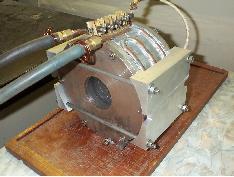

As a result, there are two constructions of the ion-optical channel of tandem accelerator for the H- beam with the initial ions energy of 25 keV and current of 10 mA: with "weak" and "strong" beam focusing.
..Introduction.. . ..Project.. . ..Publications.. . ..News.. . ..Links.. . ..For Investors.. . ..
 ..
..
One of the parts of tandem accelerator is ion-optical channel, which should have the following functionality:
1. Transportation of the negative ion beam from the source to the accelerator.
2. Acceleration of negative ions in the first accelerating gap up to the energy of 1.25 MeV with minimal precipitation of the beam on intermediate electrodes.
3. Maximum passing of ion beam through the charge-exchange tube.
4. Acceleration of the proton beam in the second accelerating gap to the energy of 2.5 MeV with minimal precipitation of the beam on intermediate electrodes.
Numerical simulation of dense H- beam transport from the source through the charge-exchange target up to outlet of the accelerator in electric and magnetic fields was carried out taking into account beam space charge and emittance. Optical focusing system was optimized for transporting negative hydrogen ion beam without significant increase of the beam emittance. The minimization of effect of space charge compensation was desirable.
Two ways of transporting the dc high current beam of negative hydrogen ions from ion source to the accelerator were considered: the one using axisymmetric lens and another using magnetic lens. Despite big power consumption it was recommended to use magnetic lenses for realization, because they allow transportation of fully compensated beam of negative hydrogen ions; and since it was possible to choose their position without changing the channel construction.
Two schemes of coordinated transportation of negative 25 keV hydrogen ion beam of in the tandem accelerator were examined; they are the "strong" scheme with the use of strong magnetic lens and beam overfocusing at the entrance to accelerator, and "weak" introduction without beam overfocusing with increased first gap and more smooth increase of electric field intensity in tandem. Since both of the schemes have advantages and disadvantages and both of them have only slight difference in the ion-optical path designs, the recommended solution is to provide the possibility to check both "weak" and "strong" beam focusing experimentally.
The optimal geometry of magnetic screen providing minimum aberrations introduced by the lens and the absence of saturation effects was determined. Magnetic lens like a folding solenoid with outer water cooling was designed and manufactured.


As a result, there are two constructions of the ion-optical channel of tandem accelerator for the H- beam with the initial ions energy of 25 keV and current of 10 mA: with "weak" and "strong" beam focusing.
In details:

G. Derevyankin, G. Kraynov, A. Kryuchkov, G. Silvestrov, S. Taskaev, M. Tiunov. The ion-optical channel of 2.5 MeV 10 mA tandem accelerator.
Preprint BINP 2002-24. Novosibirsk, 2002.
[.html file]
[.pdf file]